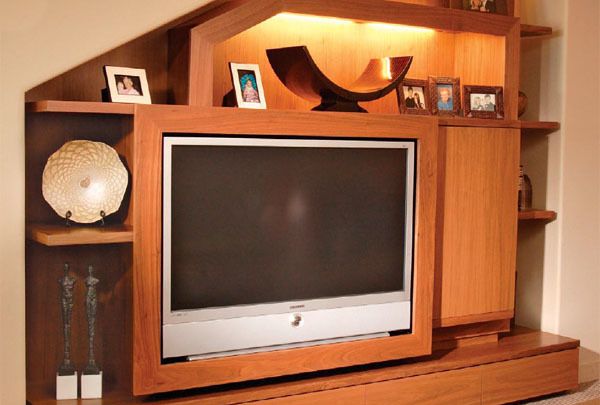Furniture for Your Next TV
Flat-panel screens and shallow boxes offer new design possibilities
Synopsis: With television screens much wider and consoles much thinner than ever before, the furniture design possibilities for housing video equipment have grown exponentially. Steve Casey, who has been designing home theater, entertainment centers, and other pieces built around televisions for nearly 30 years, has had the chance to rethink the typical entertainment center and to create cabinetry and furniture for TVs that was not practical or even possible just a few years ago. Here, he shares highlights of what he has learned.
I’ve been designing and building custom furniture since 1978, much of it devoted to home theater, entertainment centers, and other pieces built around televisions. Recent years have brought major changes in TV technology, creating new furniture possibilities and making my work much more interesting.
TV screens are wider than ever, but the most important change for furniture makers is in how thin the sets have become. Two types of sets have led the way. The first are flat-panel sets with plasma or liquid crystal screens. Some of these displays measure 60 in. diagonally but are only about 5 in. deep. The other type of set is the largescreen projection TV, which used to be housed in a giant cabinet but now averages only about 17 in. deep. The advantage of the latter type is that they cost thousands of dollars less than plasma or LCD sets with comparable screen sizes.
The new sets allow designers to rethink the typical entertainment center and to create cabinetry and furniture for TVs that was not practical or even possible just a few years ago. Televisions today are attractive enough that they don’t have to be hidden behind doors in the now-too-familiar black box. Many new designs put the set on display. Here are a few ideas.
Options for flat screens
Because TVs now can be hung on the wall like pictures, with minimal intrusion into the room, furniture makers are not limited to “big box” solutions like armoires. Instead, we can create equipment consoles that sit beneath the screens, or mount screens into the shallow bookcase section of traditional built-in cabinets.
It is important to follow proper construction techniques when building equipment furniture and cabinetry. If you plan to build an entertainment unit based on any of the design ideas presented here, Brooks Tanner’s article “Engineering an Entertainment Center” (FWW #159, pp. 78-83) provides the basics.
Console units—One piece I often build to go with flat-panel TVs is the console—an ideal furniture design for housing electronic gear in small spaces such as bedrooms or apartments. Consoles support or sit underneath the TV but do not enclose it.
The console’s smaller scale offers several advantages over conventional wall units. It is relatively easy to move when users want to relocate the piece or get behind it to connect equipment. Also, because the console doesn’t house the TV itself, there is no need to buy new furniture if you buy a bigger set. Being of smaller scale, consoles are less expensive and take less time to build than larger wall units or full-on cabinet Options for flat screens systems.
Visit Steve Casey’s archived blog and read his chronicle of the construction of a modern entertainment center for a next-generation TV. Read more…
From Fine Woodworking #183
For the full article, download the PDF below:
Fine Woodworking Recommended Products

Blackwing Pencils

Dividers























Log in or create an account to post a comment.
Sign up Log in